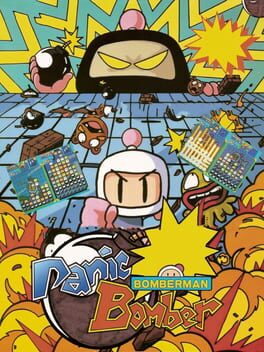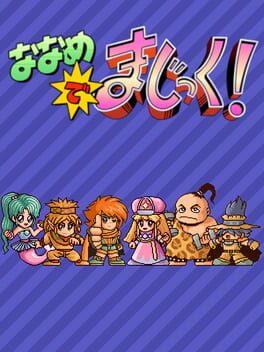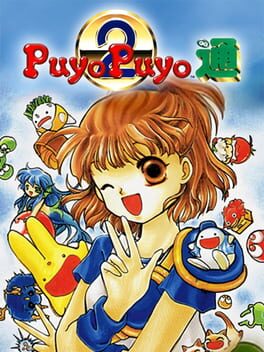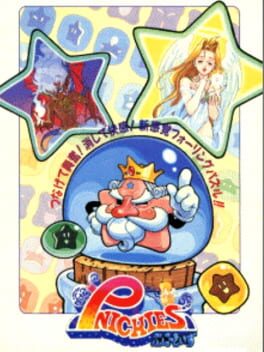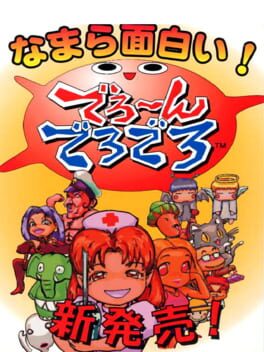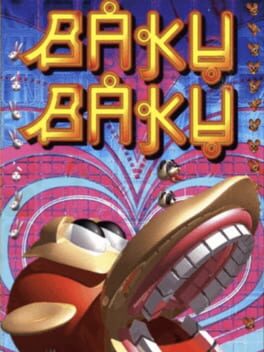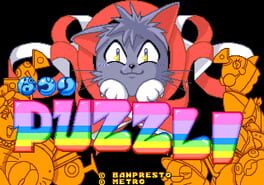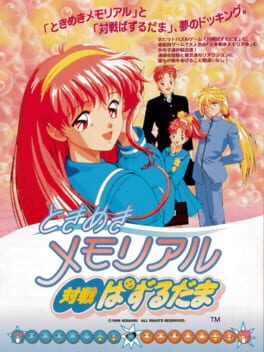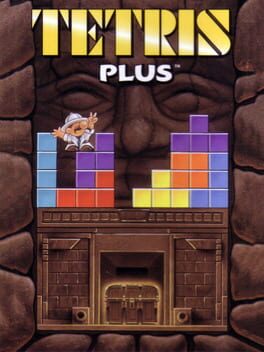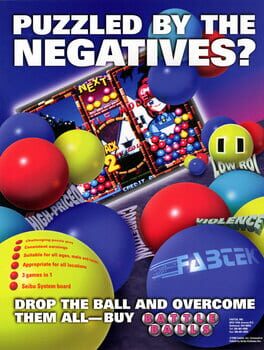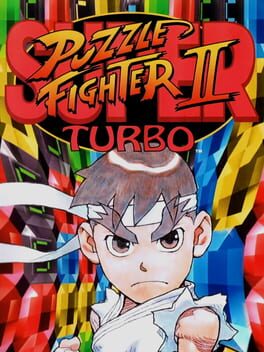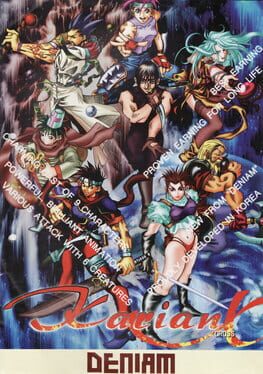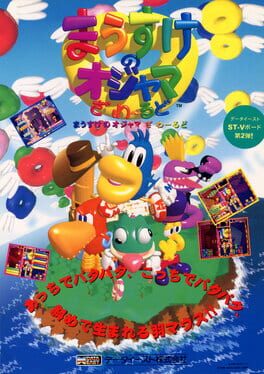bedsores
1994
if your puzzle game needs a flashing indicator to tell players where they can stack or clear -- doesn't that mean you haven't made the design speak for itself? TORYUMON, like SEN-KNOW, is trapped in its messy visualistic overly specific building-block subgenre. as the devlog indicates, it's easy to create pure failstates where placing a pattern against the wall completely screws you. SEN-KNOW manages this with a strange, under-indicated block-decay system. as for this game? the devlog gives us a perfect picture of the design challenge: the math doesn't work! there are too many types of block! making the garbage blocks be four quarter circles is a hack at best, a bandaid at worst. leon did demonstrate to me how powerful the chain-theory of high-level play can be, but much like high-level sen-know, the level of abstraction and specialization is pretty out there.
look: the music rocks, the sound design is nice and crispy, some of the best i've seen in this series. the game commits hard and well its aesthetic, unfortunately alongside Chinese stereotypes that Japanese devs often fall into. i love that the playfield a place, a door; that touch three-dimensionalizes the game into place-ness that i find truly admirable. as leon noted, having character-specific traits that aren't drop tables is truly great, maybe only CALCUNE comes to mind as an alternative pick, and this seems way more balanced. still i... the dev said it himself, and leon summarized it as such: "this game was mainly a historical afterthought." sen-know was an aesthetic tour-de-force, and this is...a few tweaks away from being "not a game." 6.0/10
info on jamp via https://gdri.smspower.org/wiki/index.php/JAMP
game development in the Phillipines: https://www.scribd.com/document/56911359/Game-Development-in-the-Philippines-1992-2008
the devlog in question. please note i read out a machine translation, so i apologize for the many inaccuracies. i'm having a lot of trouble figuring out who exactly the hell wrote this, but here you go: https://www.wizforest.com/diary/150305.html;
leon's cohost: https://cohost.org/leon
Vikas music's excellent channel of eurobeat remixes: https://www.youtube.com/channel/UCWQ4IVOuXa8M9htzbaSKlmg
a 1cc playthrough by webbedspace: https://www.youtube.com/watch?v=4OQTrOW9lVE
look: the music rocks, the sound design is nice and crispy, some of the best i've seen in this series. the game commits hard and well its aesthetic, unfortunately alongside Chinese stereotypes that Japanese devs often fall into. i love that the playfield a place, a door; that touch three-dimensionalizes the game into place-ness that i find truly admirable. as leon noted, having character-specific traits that aren't drop tables is truly great, maybe only CALCUNE comes to mind as an alternative pick, and this seems way more balanced. still i... the dev said it himself, and leon summarized it as such: "this game was mainly a historical afterthought." sen-know was an aesthetic tour-de-force, and this is...a few tweaks away from being "not a game." 6.0/10
info on jamp via https://gdri.smspower.org/wiki/index.php/JAMP
game development in the Phillipines: https://www.scribd.com/document/56911359/Game-Development-in-the-Philippines-1992-2008
the devlog in question. please note i read out a machine translation, so i apologize for the many inaccuracies. i'm having a lot of trouble figuring out who exactly the hell wrote this, but here you go: https://www.wizforest.com/diary/150305.html;
leon's cohost: https://cohost.org/leon
Vikas music's excellent channel of eurobeat remixes: https://www.youtube.com/channel/UCWQ4IVOuXa8M9htzbaSKlmg
a 1cc playthrough by webbedspace: https://www.youtube.com/watch?v=4OQTrOW9lVE
This game's presentation is more thoughtful, rich, and thorough than most, even this team's other game on my list MONSTER SLIDER. I love the story, the garbage blocks, the sound design (however doinky woinky it may be). They clearly put some thought into enemy AI's that reflect their character (like Bunny's frog stacking!). The calligraphic style gathers all elements into a wondrous fairy tale. Unfortunately: omnidirectional match-3 sucks. No way around it. The shared piece preview is just weird; i can't see it being truly a competitive element in high-level play. Yes, clearing chests with the bubbles adds garbage to your combo, which offsets the numbing tiny placements. But it's just wrong. It's just wrong and not good. I have to give a lot of points for how gorgeous this is, but i think it's gameplay fails completely. 6.5/10
I'm so far removed from the game that I don't have much to add. I did learn afterwards that Eighting is full of staff from Compile, esp. Kazuyuki Nakashima and Kenichi Yokoo. (Also uh when Toaplan disbanded some people went to Raizing which is for the purpose of our discussion basically Eighting, and some of the ones who didn't go there went on to Akumi, Gazelle, and most notably Cave.) Eighting mostly makes licensed games now but did make the immaculate and unmatched non-ochimono puzzle game Kuru Kuru Kururin.
1994
compared with Mausuke no Ojama The World, this is a stunning triumph of a diagonal stacker. using the now-familiar clearing rulesets from Columns, the player focuses on the diagonal play (the hardest part for me!) and develops it into a whole layered mechanic. there was a learning curve, but unlike the blog post we discuss (and two puzzle wednesday freaks apparently!) i found myself delighting in trying to learn this.this is our first see-saw multiplayer type, the only other example i can think of is Petal Crash.
beyond the writing, the cute characters, the layered ui design, the satisfying "two players fighting" simulacrum, and the lovely music, we should highlight two interesting features:
1) drop speed graduates from being a simple execution barrier to a managed resource. one can clear three hourglass blocks to slow it, if one has the time to. (this does imply Margin Time, so depending on when this game was released, it invalidates my hypothesis!)
2) ! blocks are double-headed dangers. they turn your bubbles into your element BUT ALSO turn your opponent's element into bubbles. being able to use this one "super" mechanic for offense and defense, depending on the scenario, is a delightful bit of design. it is also, perhaps, too much of a come-from-behind swing to make the game feel fair -- being destroyed out of nowhere is just not "good design" most of the time.
overal, i like it and i think it's really good. i'm hungry right now so i'm not a good judge of anything. but i think fed me would say: 8.5, BNM (best new magic).
beyond the writing, the cute characters, the layered ui design, the satisfying "two players fighting" simulacrum, and the lovely music, we should highlight two interesting features:
1) drop speed graduates from being a simple execution barrier to a managed resource. one can clear three hourglass blocks to slow it, if one has the time to. (this does imply Margin Time, so depending on when this game was released, it invalidates my hypothesis!)
2) ! blocks are double-headed dangers. they turn your bubbles into your element BUT ALSO turn your opponent's element into bubbles. being able to use this one "super" mechanic for offense and defense, depending on the scenario, is a delightful bit of design. it is also, perhaps, too much of a come-from-behind swing to make the game feel fair -- being destroyed out of nowhere is just not "good design" most of the time.
overal, i like it and i think it's really good. i'm hungry right now so i'm not a good judge of anything. but i think fed me would say: 8.5, BNM (best new magic).
1994
We can certainly praise Puyo Puyo Tsu for presenting essential new rules to the series; as seckswrecks said to me a ways back, completetive Puyo was just a race to get a 5-chain before Tsu. But I have a bolder hypothesis: Puyo Puyo Tsu originated four completely new rules to the stacker genre which would become foundational to literally all stacker design to come, literally forever. Please call me out if you have counter-examples, documentation is limited and i still have (regrettably) not yet played every puzzle game. I'll include counter-examples in edits to this document. Anyway, here are those rules, gathered via PuyoNexus:
1) "offset rule," what i've called garbage cancelling: to paraphrase PuyoNexus, "the player can reduce or 'offset' the amount of incoming garbage with their own garbage; should the player completely negate all incoming garbage, any excess will be sent to the opponent." as i've oft opined, this rule is what makes multiplayer stackers work. it is near-universal in any game with queued garbage.
2) "margin time": after a certain amount of time has passed, the game will intensify the effect of chains by making the same chain send more garbage. one can apply the concept of margin time to any mechanic that speeds up or intensifies over the course of a single match, tightening the execution window or heightening the risk/reward tension. this maps the increasing speed one encounters over long plays of tetris or columns into a shorter multiplayer format.
3) "all clear": if a player manages to clear their field of pieces after the game starts, they receive a bonus to points/garbage. this bonus drives the most brutal strategies in the Tetris meta today.
4) "double rotation": if a piece is falling through a column too narrow to rotate, the player can double-tap the rotate button, and the top and bottom pieces will swap.
To me, these four mechanics are up there with "color matching," "chaining," "rotation," "wallkick," and "garbage" with their impact on our budding genre. (maybe not "double rotation" as much, but the first three, yeah absolutely, i'd defend that.) first or not, here they are together in 1994: four years after Columns, six years after the first commercial releases of Tetris, nine years after CHAIN SHOT, fourteen years after PAC-MAN, at least 3300 years since fucking Tic-Tac-Toe. unlike Tetris (1985), which spawned Tetris clones (many of which were not very good), and Columns (1990), which spawned Columns clones (many of which have naked ladies in them), Puyo Puyo Tsu (1994) spawned the competitive puzzle game as we know it today. what Puyo Puyo Tsu introduced, the world grabbed; what Puyo Puyo Tsu refined, the world swallowed; what Puyo Puyo Tsu meant, the world became.
...which is all perhaps a bit much for a junior researcher of puzzle games to say! like, i didn't know what CHAIN SHOT was until writing this. but this is that which my heart sings right now, so i hope old heads don't rag on me too hard about this. i hope to revisit this at the end of the project, but for now: a perfect 10/10.
1) "offset rule," what i've called garbage cancelling: to paraphrase PuyoNexus, "the player can reduce or 'offset' the amount of incoming garbage with their own garbage; should the player completely negate all incoming garbage, any excess will be sent to the opponent." as i've oft opined, this rule is what makes multiplayer stackers work. it is near-universal in any game with queued garbage.
2) "margin time": after a certain amount of time has passed, the game will intensify the effect of chains by making the same chain send more garbage. one can apply the concept of margin time to any mechanic that speeds up or intensifies over the course of a single match, tightening the execution window or heightening the risk/reward tension. this maps the increasing speed one encounters over long plays of tetris or columns into a shorter multiplayer format.
3) "all clear": if a player manages to clear their field of pieces after the game starts, they receive a bonus to points/garbage. this bonus drives the most brutal strategies in the Tetris meta today.
4) "double rotation": if a piece is falling through a column too narrow to rotate, the player can double-tap the rotate button, and the top and bottom pieces will swap.
To me, these four mechanics are up there with "color matching," "chaining," "rotation," "wallkick," and "garbage" with their impact on our budding genre. (maybe not "double rotation" as much, but the first three, yeah absolutely, i'd defend that.) first or not, here they are together in 1994: four years after Columns, six years after the first commercial releases of Tetris, nine years after CHAIN SHOT, fourteen years after PAC-MAN, at least 3300 years since fucking Tic-Tac-Toe. unlike Tetris (1985), which spawned Tetris clones (many of which were not very good), and Columns (1990), which spawned Columns clones (many of which have naked ladies in them), Puyo Puyo Tsu (1994) spawned the competitive puzzle game as we know it today. what Puyo Puyo Tsu introduced, the world grabbed; what Puyo Puyo Tsu refined, the world swallowed; what Puyo Puyo Tsu meant, the world became.
...which is all perhaps a bit much for a junior researcher of puzzle games to say! like, i didn't know what CHAIN SHOT was until writing this. but this is that which my heart sings right now, so i hope old heads don't rag on me too hard about this. i hope to revisit this at the end of the project, but for now: a perfect 10/10.
1994
we're going to run into more and more titles that are underdeveloped. though i'm not a scholar of the industry, i'd blame the breakneck pace of game production and the niche status of puzzle games. it leads to an interesting challenge for us as reviewers: do we judge a released game like this by the standards of a demo, or a standards of a polished product? i'm going to lean towards being judgemental, like "you shouldn't have shipped a product with obvious flaws"; however, know i do so with love and acknowledgement for the precarious position these developers were in. in that spirit: this game isn't great, but it's historically fascinating and a brilliant opportunity to get to what makes puzzle games fun.
historically speaking, we have a narrative: compile mostly developed this game and licensed it to capcom. or perhaps capcom developed the gameplay sketch and licensed it to capcom, who filled out development. either way, pnickies suggests a direct line from the puzzle GOATs to Super Puzzle Fighter 2 Turbo. if we consider the lack of CPU opponents as signs of underdevelopment (like, c'mon, compile would've known better), we could even claim it's a demo for SPF2T. it plays more like SPF2T than baku baku animal; triggers can clear each other, and like color groups blend together to reduce visual noise (although the colorblind accessibility leaves much to be desired). though it's surprised me that SPF2T devs didn't have puzzle experience, the strong product they made can be attributed both to their skill and perhaps to this blueprint they were provided.
as to the fun: fightcade is a miracle! the garbage back-and-forth is simple and satisfying. chaining gets results. not much to say beyond what we've already seen. the joy of meeting a friend at a cab lives on. it's not the perfectly tuned experience we've become used to. but the presentation is nice, the music's good, there's plenty of visual interest and craft. anytime i get to say "i lost, yay!!" that's a game i want to play. sucks about the no cpu tho.
historically speaking, we have a narrative: compile mostly developed this game and licensed it to capcom. or perhaps capcom developed the gameplay sketch and licensed it to capcom, who filled out development. either way, pnickies suggests a direct line from the puzzle GOATs to Super Puzzle Fighter 2 Turbo. if we consider the lack of CPU opponents as signs of underdevelopment (like, c'mon, compile would've known better), we could even claim it's a demo for SPF2T. it plays more like SPF2T than baku baku animal; triggers can clear each other, and like color groups blend together to reduce visual noise (although the colorblind accessibility leaves much to be desired). though it's surprised me that SPF2T devs didn't have puzzle experience, the strong product they made can be attributed both to their skill and perhaps to this blueprint they were provided.
as to the fun: fightcade is a miracle! the garbage back-and-forth is simple and satisfying. chaining gets results. not much to say beyond what we've already seen. the joy of meeting a friend at a cab lives on. it's not the perfectly tuned experience we've become used to. but the presentation is nice, the music's good, there's plenty of visual interest and craft. anytime i get to say "i lost, yay!!" that's a game i want to play. sucks about the no cpu tho.
1995
chat reminded me of two methods of inquiry I often ignore when writing these short little writeups: personnel history and contemporary reviews. For personnel, I'd been using the shorthand of calling things a Sega game, or a Data East game, but corporations don't make games! People do, so I dug in. I knew that crediting of developers was spotty back then, but I was more shocked to realize I was wrong about how I thought the industry worked. I expected the following: a developer wants to make a puzzle game, they call a designer (in-house or not) experienced in puzzle games, they lead a team, and a puzzle game gets made. What I've found so far is the opposite. From programming to designing to directing and producing, most credited people on ochimono games we've played so far only worked on one puzzle game their whole career. Yes, this reflects accurately on the genre niche these games occupy, but moreover there isn't a progression of design development. Companies would simply hire someone they trusted within their department to direct or design or program regardless of their puzzle experience.
For examples: DDD's "Leader" Kimihiko Nakamura had done senior and general programmer for Super Tecmo Bowls I and III respectively, then much much later in his career served as Planner for Ape Escape 3. Lead Programmer Shinichiro Yamamoto undertook Main Programming for DDD as his first credited project, and later made nothing related. Hiroaki Matsui began his career as the staff programmer for this game; he was the one who suggested the blocks "stretch like slime." He'd go on to work extensively as artist, writer, designer, and director for Dead or Alive 1-4, four Ninja Gaiden games, and Tokyo Mirage Sessions #FE of all things, among others. This pattern repeats for every puzzle game we've played that I can find credits for -- except, of course, for members of SEGA AM3, Compile, Arika, and Data East. Putting those exceptions aside, these puzzle games are developmental islands. Their staff and concepts stand alone in the sea of their parent company, save for whatever the developers osmosed from the games they played personally. Maybe this is why few studios implemented garbage cancelling after 1994, despite it improving Puyo Puyo Tsu so drastically over its predecessor. Each company paid developers to reinvent the wheel for the puzzle fad, then moved them along to action games.
The review history is lighter fare. Both GamePro and EGM commented on how "disturbing" the block stretching is, while IGN's reviewer was the only one brave enough to call it "strangely arousing." Also, only IGN correctly identified that the music is good. Stunning to me how much better reviewed Baku Baku Animal was than this. There's a gem to reflect on, though: Sushi-X of EGM noted how easy combing is, derogatorily. Trying to find high-level play on youtube lead me to speedrun videos (under the game's anglicized title, Tecmo Stackers) which simply applied puyo puyo strategy without much use of the tentacle mechanics. I feel like this game has a higher skill ceiling and unique play style out there waiting for it, but there's no proof anybody's found it yet, so, who knows if I know what I'm talking about.
Anyway, this game is good.
For examples: DDD's "Leader" Kimihiko Nakamura had done senior and general programmer for Super Tecmo Bowls I and III respectively, then much much later in his career served as Planner for Ape Escape 3. Lead Programmer Shinichiro Yamamoto undertook Main Programming for DDD as his first credited project, and later made nothing related. Hiroaki Matsui began his career as the staff programmer for this game; he was the one who suggested the blocks "stretch like slime." He'd go on to work extensively as artist, writer, designer, and director for Dead or Alive 1-4, four Ninja Gaiden games, and Tokyo Mirage Sessions #FE of all things, among others. This pattern repeats for every puzzle game we've played that I can find credits for -- except, of course, for members of SEGA AM3, Compile, Arika, and Data East. Putting those exceptions aside, these puzzle games are developmental islands. Their staff and concepts stand alone in the sea of their parent company, save for whatever the developers osmosed from the games they played personally. Maybe this is why few studios implemented garbage cancelling after 1994, despite it improving Puyo Puyo Tsu so drastically over its predecessor. Each company paid developers to reinvent the wheel for the puzzle fad, then moved them along to action games.
The review history is lighter fare. Both GamePro and EGM commented on how "disturbing" the block stretching is, while IGN's reviewer was the only one brave enough to call it "strangely arousing." Also, only IGN correctly identified that the music is good. Stunning to me how much better reviewed Baku Baku Animal was than this. There's a gem to reflect on, though: Sushi-X of EGM noted how easy combing is, derogatorily. Trying to find high-level play on youtube lead me to speedrun videos (under the game's anglicized title, Tecmo Stackers) which simply applied puyo puyo strategy without much use of the tentacle mechanics. I feel like this game has a higher skill ceiling and unique play style out there waiting for it, but there's no proof anybody's found it yet, so, who knows if I know what I'm talking about.
Anyway, this game is good.
1995
i hedge my bets in my judgement of the 3D a fair bit in this video, which was (alongside its mechanics and gameplay) widely praised at the time. and yes, i think they were going for a primary-color, platonic-solid vibe. so a modern observer must filter a) how 3D models from the 90s feel rudimentary compared to now, and b) how this game is purposefully rudimentary compared to the graphics of its own time. Still, in the weeks since, i've concluded it's a failed aesthetic. Fairy-tale stories don't need to look rudimentary to get their point across; hell, dragon quest games didn't purposefully keep themselves behind the graphical curve. This is the year of Virtua Fighter 2, Alpine Racer, Wipeout and Twisted Metal. "We were trying to be bad" isn't much of an excuse; this was a flawed aesthetic goal, even if it executed on its goal accurately. (And trust me, the Saturn version doesn't look much better!)
Color stackers often increase their difficulty by increasing the number of colors involved; 5-color puyo is way different than 4-color puyo. Although this is technically a four-color stacker with four specialized trigger blocks, in practice i find it to be an 8-color stacker, and it plays only-somewhat-less-unweildily than that moniker suggests. There's even a 5-animal, 10-color mode, if you're a true sicko! There's a reason why Puzzle Fighter would later reuse a similar fomula, but use only three colors -- ACTUALLY THAT'S WRONG, SEE BELOW. That said, I think the way garbage is handled in this game is revolutionary. Sending random blocks to your opponent requires them to adapt on the fly to the upper structure of their stack changing AND find potential new patterns within it. In contrast, Tetris garbage merely raises your stack up, decreasing your execution time; Taisen Puzzle-dama's drop tables give you essentially readymade combos if you're prepared for them; and Puyo garbage locks out your upper structure without immediately allowing new improv.
Given the game's widespread praise at the time and the demonstrable richness of possible interplay between two skilled players, I'm ready to give this a higher score while sighing that it's "just not for me." But! I would honestly have expected more out of Sega and their flagship Saturn puzzle game.
---
ADDENDUM:
In my generous yet negative review of Baku Baku Animal, i complained incorrectly that Super Puzzle Fighter 2 Turbo has three colors to BBA's four. @leon corrected me -- they both have four colors!! -- and it left me wondering why i specifically dislike BBA compared to SPF2T. both games feature four colors divided into trigger and block pieces; when a trigger piece is added to a group of like blocks, they clear, and garbage is sent to the opponent. why did BBA feel unwieldy and unpleasant to me compared to SPF2T? am i just a hater because BBA looks kinda goofy to me? i wanted to interrogate my preferences more rigorously, so i have three claims to make about how SPF2T is better: aesthetics, tuning, and mechanics.
Aesthetics
Advanced puzzle players will need to know their board state quickly and efficiently so they can focus on identifying the upcoming pieces, determining a plan for next peices, and reading their opponents board state. But these eight symbols' visual business rebuffs a player seeking such immediate, clearly presented knowledge. In contrast, five-color Puyo Puyo conveys piece identification with both color AND associated facial expressions, double-reinforcing the player's board state after a quick glance. This essential visual elegance becomes more challenging to implement with trigger-based mechanics that doubling the total block types AND require the pair-ed-ness of certain blocks to be immediately apparent.
BBA's blocks are visually messy. The 4 trigger pieces and 4 color pieces each have a unique symbol relying on our childhood association with animal diets: monkey like banana, rabbit munch carrot, panda scarf bamboo, and dog chew bone. The four pairs do share a mascot color (yellow, red, green, and blue respectively), though only close to the margins of a block. It's hard for me, as an admittedly less experienced player, to immediately "read" my board state, because i have to sift through a great deal more information -- marginal color information, animal association, and visual patterning -- to get my split-second read.
SPF2T's blocks are visually oversimplified. Triggers are circular and wispy, blocks are square and crystalline. Like-colored blocks fuse into meta-cubes with distinct outer edges, signifying a concentration of pieces. The four pairs of blocks are linked by their color: yellow, red, green, or blue. This is mostly enough for me as a color-sighted person, though i lose some of the double-reinforcement of hue- AND texture-distinct colorblind accessible design (e.g., again, Puyo Puyo). Thankfully, both the official Capcom release in Capcom Fighting Collection and a variety of fanpatches (including one by our very own @trashboatdagod) alter the four colors to ones more accessible to two common types of colorblindness (not monochromacy unfortunately).
Of the two, SPF2T is demonstrably simpler and easier for me to read, BBA's block patterns require much more practice to develop a split-second board-state read. YMMV as a color-blind person; I'd be curious to know how Baku Baku Animal's use of visually eight distinct symbols helps or hinders your quick reads.
Tuning
My experience with BBA has been marked by a clogged board filled with orphaned trigger pieces I can't use or get rid of. I don't have a decompile of either game (nor the skill to read it), so it's not possible with total certainty to know how the piece randomizer works in either game. So i set out to discover, both intuitively and empirically, how often BBA gives the player trigger pieces compared to SPF2T. In the normal mode of each game I quickly filled the board with pieces without clearing any, and then paused emulation to count how many of each type of block I'd gotten in total. I did 10 rounds of this for each game, yielding data for 560 BBA blocks and 503 SPF2T blocks. I compared the color prevalence and trigger-piece prevalance over the two sets; you can see the resultant charts at the top of the post.
Casually, it definitely looks like BBA gives you trigger pieces a little over a quarter of the time, while SPF2T gives you trigger pieces a little over a fifth of the time. I can't confirm those "true ratio" numbers with such a small sample size. I can say (via a 2.52 chi-squared test result) the two trigger-piece-averages are not the same with a p-value of 0.11. That's not strong enough for scientific work (you need like p < 0.05), but it's also not nothin'. I will tentatively claim, therefore, that my intuition about trigger-piece frequency looks to be about right, and leave the last word on it to a decompiled piece randomizer function.
Mechanics
Most importantly, two essential mechanics combine to make SPF2T work unequivocally better when it comes to trigger-piece balance than BBA:
In SPF2T, unlike BBA, trigger pieces trigger other trigger pieces of the same color. Two green trigger pieces in SPF2T will self-annihilate, whereas two Pandas next to each other in BBA will hang out on the board. (And like, good for them, but it makes my life harder.)
In SPF2T, unlike BBA, the clear-all-of-one-color block (in this case, Diamonds) will clear both regular blocks AND trigger pieces of that color. In BBA, the equivalent BB coin will clear all of only one type of block: all bamboo will clear but not pandas, or all pandas will clear but not bamboo. SPF2T lets you clear literally twice the block types
A player is much less likely to orphan trigger pieces they can't use or get rid of. Resultantly, even though SPF2T's playfield is smaller than BBA's, SPF2T feels less cramped atomically. get wrecked, get owned
Color stackers often increase their difficulty by increasing the number of colors involved; 5-color puyo is way different than 4-color puyo. Although this is technically a four-color stacker with four specialized trigger blocks, in practice i find it to be an 8-color stacker, and it plays only-somewhat-less-unweildily than that moniker suggests. There's even a 5-animal, 10-color mode, if you're a true sicko! There's a reason why Puzzle Fighter would later reuse a similar fomula, but use only three colors -- ACTUALLY THAT'S WRONG, SEE BELOW. That said, I think the way garbage is handled in this game is revolutionary. Sending random blocks to your opponent requires them to adapt on the fly to the upper structure of their stack changing AND find potential new patterns within it. In contrast, Tetris garbage merely raises your stack up, decreasing your execution time; Taisen Puzzle-dama's drop tables give you essentially readymade combos if you're prepared for them; and Puyo garbage locks out your upper structure without immediately allowing new improv.
Given the game's widespread praise at the time and the demonstrable richness of possible interplay between two skilled players, I'm ready to give this a higher score while sighing that it's "just not for me." But! I would honestly have expected more out of Sega and their flagship Saturn puzzle game.
---
ADDENDUM:
In my generous yet negative review of Baku Baku Animal, i complained incorrectly that Super Puzzle Fighter 2 Turbo has three colors to BBA's four. @leon corrected me -- they both have four colors!! -- and it left me wondering why i specifically dislike BBA compared to SPF2T. both games feature four colors divided into trigger and block pieces; when a trigger piece is added to a group of like blocks, they clear, and garbage is sent to the opponent. why did BBA feel unwieldy and unpleasant to me compared to SPF2T? am i just a hater because BBA looks kinda goofy to me? i wanted to interrogate my preferences more rigorously, so i have three claims to make about how SPF2T is better: aesthetics, tuning, and mechanics.
Aesthetics
Advanced puzzle players will need to know their board state quickly and efficiently so they can focus on identifying the upcoming pieces, determining a plan for next peices, and reading their opponents board state. But these eight symbols' visual business rebuffs a player seeking such immediate, clearly presented knowledge. In contrast, five-color Puyo Puyo conveys piece identification with both color AND associated facial expressions, double-reinforcing the player's board state after a quick glance. This essential visual elegance becomes more challenging to implement with trigger-based mechanics that doubling the total block types AND require the pair-ed-ness of certain blocks to be immediately apparent.
BBA's blocks are visually messy. The 4 trigger pieces and 4 color pieces each have a unique symbol relying on our childhood association with animal diets: monkey like banana, rabbit munch carrot, panda scarf bamboo, and dog chew bone. The four pairs do share a mascot color (yellow, red, green, and blue respectively), though only close to the margins of a block. It's hard for me, as an admittedly less experienced player, to immediately "read" my board state, because i have to sift through a great deal more information -- marginal color information, animal association, and visual patterning -- to get my split-second read.
SPF2T's blocks are visually oversimplified. Triggers are circular and wispy, blocks are square and crystalline. Like-colored blocks fuse into meta-cubes with distinct outer edges, signifying a concentration of pieces. The four pairs of blocks are linked by their color: yellow, red, green, or blue. This is mostly enough for me as a color-sighted person, though i lose some of the double-reinforcement of hue- AND texture-distinct colorblind accessible design (e.g., again, Puyo Puyo). Thankfully, both the official Capcom release in Capcom Fighting Collection and a variety of fanpatches (including one by our very own @trashboatdagod) alter the four colors to ones more accessible to two common types of colorblindness (not monochromacy unfortunately).
Of the two, SPF2T is demonstrably simpler and easier for me to read, BBA's block patterns require much more practice to develop a split-second board-state read. YMMV as a color-blind person; I'd be curious to know how Baku Baku Animal's use of visually eight distinct symbols helps or hinders your quick reads.
Tuning
My experience with BBA has been marked by a clogged board filled with orphaned trigger pieces I can't use or get rid of. I don't have a decompile of either game (nor the skill to read it), so it's not possible with total certainty to know how the piece randomizer works in either game. So i set out to discover, both intuitively and empirically, how often BBA gives the player trigger pieces compared to SPF2T. In the normal mode of each game I quickly filled the board with pieces without clearing any, and then paused emulation to count how many of each type of block I'd gotten in total. I did 10 rounds of this for each game, yielding data for 560 BBA blocks and 503 SPF2T blocks. I compared the color prevalence and trigger-piece prevalance over the two sets; you can see the resultant charts at the top of the post.
Casually, it definitely looks like BBA gives you trigger pieces a little over a quarter of the time, while SPF2T gives you trigger pieces a little over a fifth of the time. I can't confirm those "true ratio" numbers with such a small sample size. I can say (via a 2.52 chi-squared test result) the two trigger-piece-averages are not the same with a p-value of 0.11. That's not strong enough for scientific work (you need like p < 0.05), but it's also not nothin'. I will tentatively claim, therefore, that my intuition about trigger-piece frequency looks to be about right, and leave the last word on it to a decompiled piece randomizer function.
Mechanics
Most importantly, two essential mechanics combine to make SPF2T work unequivocally better when it comes to trigger-piece balance than BBA:
In SPF2T, unlike BBA, trigger pieces trigger other trigger pieces of the same color. Two green trigger pieces in SPF2T will self-annihilate, whereas two Pandas next to each other in BBA will hang out on the board. (And like, good for them, but it makes my life harder.)
In SPF2T, unlike BBA, the clear-all-of-one-color block (in this case, Diamonds) will clear both regular blocks AND trigger pieces of that color. In BBA, the equivalent BB coin will clear all of only one type of block: all bamboo will clear but not pandas, or all pandas will clear but not bamboo. SPF2T lets you clear literally twice the block types
A player is much less likely to orphan trigger pieces they can't use or get rid of. Resultantly, even though SPF2T's playfield is smaller than BBA's, SPF2T feels less cramped atomically. get wrecked, get owned
TBD
this is puzzli! it's like puzzli 2. it's cute and the gameplay loop is okay and it's not ochimono. the screen-side UI is a delight. recognizeable characters communicate combo indicators, normal play, danger level, and water level all appear with fluid transition. and puzzli is turn-based, with no reward for faster clears. so it's chill. i'm adjusting my rating of puzzli 2 to match this, a solid 6.0 for the gorgeousness of presentation.
Although the arcade can be only a pale imitation of the Saturn version: wow!! Some of the best presentation and writing i can imagine in a puzzle game, sullied and scrambled by the truly awful puzzle mechanics for anyone placing in more than a passing interest. Konami was pumping out TPD games at an alarming rate, and everyone was copying them, but it wasn't it. It's a cash-grab series that took an exit off the puzzle highway to a one-way dead-end road. People learned, as time passed, not to go there. I only rarely get an urge to replay a game while editing, but I find myself lusting for the progression, the characterization seeping through each scene of this game, sad as i would be to reply through the dull ball game. Each girl begins in a tokimeki state, and proceeds through a series of challenges to deliver her letter of confession to her true love. I thought during stream that the girls were fighting over the main character, but in normal mode mostly they're just hanging out, talking shit, and finding pretenses to puzzle battle. It's an honest, refreshing joy to see them pass the bechdel test with such flying colors, and I wish I could hang out with them! But taisen puzzle-dama is, at the end of the day, unhangoutitudinous.
1995
as we head backwards into the past, i'm increasingly taken with how tetris plus and its sequel really nailed the "tetris, but" genre. color matching stackers are exploding in creativity, but the closed design of tetris hasn't lead to a longevity of tetris-likes. we'll discuss that phenomenon later once we get to the "tetris-like" boom of the late 90s and early 80s. but this half-decade hasn't brought us a lot of them -- the closest might be Cleopatra Fortune, honestly. (TGM is doing its own thing.) the Tetris Plus puzzle mode is genuinely brilliant. i'd be repeating my Tetris Plus 2 review to say more, so in short: pleasant, meaningfully distinct, very cute, rng-game-as-in-party-mode not rng-game-as-in-unfair, shame about the grave robbing but we will entomb them for their sins
1995
i actually can't rule out the possibility this game has drop tables. i've noticed differences between the number of "empty" vs. "full" balls that drop, and occasions where a player drops two colors instead of their mascot one. but the differences don't seem to matter? this game's core loop is not overly impacted, at least at my current level of play. so this game fulfills my dream! a puzzle game with primarily cosmetic character differences!
this game is certainly less angular, less brutal in its garbage curve and playstyle than a Puyo Puyo. since the playfield isn't that wide, balls tend to fall into predictable locations, and with a hex-grid, balls have more ways than ever to be connected to each other. it's gorgeously casual. it's for everybody, and i admire how open the play is.
the only element that's too complicated is the edge cases of the physics system. the whole thing, i believe, is handed: certain physics interactions will privilege one direction over the other consistently (see also early nintendo tetris games, which had LH and RH versions of the Nintendo Rotation System). it's hard to solve that elegantly, and it honestly might've been fun to make it random, although that's less friendly.
this leads me to an interesting, collarary research question: are easy and simple synonyms in puzzle game design? i certainly feel the crystallinity of spirit within this game, but does its relatively low default difficulty contribute? puyo is, like, hard, but the whole thing is so simple at its heart / base mechanics. gonna chew on this one, no answer.
great game so cute had a girl that made me lose it
this game is certainly less angular, less brutal in its garbage curve and playstyle than a Puyo Puyo. since the playfield isn't that wide, balls tend to fall into predictable locations, and with a hex-grid, balls have more ways than ever to be connected to each other. it's gorgeously casual. it's for everybody, and i admire how open the play is.
the only element that's too complicated is the edge cases of the physics system. the whole thing, i believe, is handed: certain physics interactions will privilege one direction over the other consistently (see also early nintendo tetris games, which had LH and RH versions of the Nintendo Rotation System). it's hard to solve that elegantly, and it honestly might've been fun to make it random, although that's less friendly.
this leads me to an interesting, collarary research question: are easy and simple synonyms in puzzle game design? i certainly feel the crystallinity of spirit within this game, but does its relatively low default difficulty contribute? puyo is, like, hard, but the whole thing is so simple at its heart / base mechanics. gonna chew on this one, no answer.
great game so cute had a girl that made me lose it
character-unique drop tables are a failed experiment. when a fighting game player has many possible basic choice flavors moment to moment - punch, kick, grab, block, jump, run, weak, strong - each choice gains a grain based on the chosen character. thus a player's entire 'grain of play' erupts dynamically in a conversation with their character. but in the ultra-simplified milieu of puzzle games, the player has so few basic choice flavors - stack a block, or don't - that the player develops an entire grain of play arises from their intense, obsessive iteration on how to make that single basic choice. players don't need a drop table to make this magic happen. and as it happens, it's hard to design balanced and distinct drop tables for vs puzzle games. the result is a one-dimensional tier list of which are good and which are bad, with little room for playstyle to affect the results except ath the highest levels of sophistication. maybe i need to play the rebalance hack better to judge this, but as it stands, i think the drop tables are the silliest and most unnecessary part of SPF2T. here's the kicker: even just different music, block textures, and voice lines would be enough to make people choose a favorite character! ask any mario maker player.
SPF2T makes a subtle, fascinating design design: the large power gems themselves. it is necessary for a color-matching stacker to have a chaining method that looks exciting, and SPF2T certainly adds the game-slowing glass-breaking effect while the chain is happening. but the power gems are stored power pre-combo which nevertheless take over the board aesthetically. it feels great to make a single big block, smooth and unsullied, that will be the genesis of a later attack. in other words, SPF2T pushes the aesthetic beauty of the chain backwards in time to before you even launch it. it fits a basic human instinct to find and make patterns, so that brain can go "mm yes good."
i'm glad we got fightcade working for this game! i'm hoping the series will continue to include vs play with real people, as time and popularity of game allow. it cemented the thrill in me. i do however dislike the drop table focus, as i do on the slowness of play resultant from catalyst pieces being necesssary to sieze moments, and only one piece preview to see them coming. it limits the strategic flow of the game, although i could see a stochastic method that assumes any number of pieces being possible. ah well.
SPF2T makes a subtle, fascinating design design: the large power gems themselves. it is necessary for a color-matching stacker to have a chaining method that looks exciting, and SPF2T certainly adds the game-slowing glass-breaking effect while the chain is happening. but the power gems are stored power pre-combo which nevertheless take over the board aesthetically. it feels great to make a single big block, smooth and unsullied, that will be the genesis of a later attack. in other words, SPF2T pushes the aesthetic beauty of the chain backwards in time to before you even launch it. it fits a basic human instinct to find and make patterns, so that brain can go "mm yes good."
i'm glad we got fightcade working for this game! i'm hoping the series will continue to include vs play with real people, as time and popularity of game allow. it cemented the thrill in me. i do however dislike the drop table focus, as i do on the slowness of play resultant from catalyst pieces being necesssary to sieze moments, and only one piece preview to see them coming. it limits the strategic flow of the game, although i could see a stochastic method that assumes any number of pieces being possible. ah well.
1997
PUZZLE GAMES OF 1996 DIDN'T LISTEN ENOUGH. they should have copied wholesale the subtle mechanical innovations other games made at the time: double-tap to swap 180 degrees, garbage cancelling/nullification, pieces with distinct designs per-character AND little eyes on them that look like they're hanging out. Enter Karian Cross! For all the talk of the 'Dark Ages' of the '90s South Korean game dev scene, with rampant bootlegs and plagiarism (we'll discuss later), this game steals wisely AND is deliciously devoted to its originality. The characters are cute, doofy, and memorable; their sprite representations are extremely weird but also memorable in their own gangly manner. The drop tables aren't balanced perfectly, but whose were? This is the closest a game has gotten to making me like Taisen Puzzle-dama. i'm not entirely sure, but i think that the multiplayer cheats in higher levels by giving the opponents a damage multiplier -- or Warok and Dorf just do more damge with their attacks for some reason? unfortunate, but unlike some games i won't mention, i don't feel betrayed. the whole is still good; it's not a bad game with good parts, it's a good game with bad parts.
even before the cheating, the rubberbanding, that the CPU gets at high levels: this game's multiplayer mechanics are designed and tuned wrong. its only interaction is a harassment game, an insult to the art of comboing; it's like tennis, except you're on hoverboards that automatically move to where the ball is going. all you have to do is hit, and that can be done better or worse, but the formula is automatic. the number of rows sent when clearing flying mouths is arbitrary. turns out, also, that each character does have drop tables completely hidden from the player, some of which are severely unfair (the little spaghetti guy with the top hot that says ohoho is the same, but only when the player chooses him)! for this harassment-based game, having fewer colors of garbage to send is gonna be preferable; volume that catches players off guard is what wins you the game. i so loved to see a game disrupting the "golden rule of color stackers" by making this interlaced structure. despite the ambitious graphics and cute worldbuilt, this falls way flat to me; i feel strangely betrayed.

